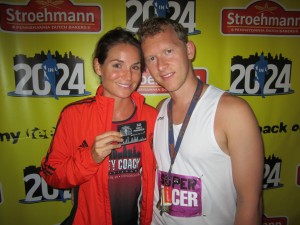 When I first started marathon training, I bought myself a Garmin 405. With a time-specific goal, I wanted a tool that would keep me honest, accountable, and aware of my progress. At the time, a $300 “investment” in my training seemed a bit steep. I was a full time actor in NYC, and when you don’t know when your next paycheck will arrive, or if you’ll even love running marathons, $300 was quite the expense for my running quest.
When I first started marathon training, I bought myself a Garmin 405. With a time-specific goal, I wanted a tool that would keep me honest, accountable, and aware of my progress. At the time, a $300 “investment” in my training seemed a bit steep. I was a full time actor in NYC, and when you don’t know when your next paycheck will arrive, or if you’ll even love running marathons, $300 was quite the expense for my running quest.
Since that purchase in July 2010, my trusty Garmin has gone through a lot. Humid summers, rain showers, snow and ice storms. Training in NYC, Philly and LA. Races all over the country. Thousands of training miles, dozens of marathons, half marathons, and countless other races. Moments of pure bliss and triumph – big PRS, overcoming what I thought was possible, and some wins. Moments of complete agony – injuries on race courses, DNFs, the trauma of the Boston Marathon in 2013 – My Garmin was there on my left wrist for all of it.
All of those miles have turned my once perfect and shiny Garmin into an old, weathered-looking device. The band has been held together with black tape for months, and there have been times where the device has completely malfunctioned, or rebooted mid-race. But like a trusty friend, these errors were forgiven.
Sure, newer models have come and gone within the last few years. Friends have tempted me to upgrade, but why? My Garmin worked just fine. Call me old fashioned, but why replace something when what you have does quite a good job? But over the last few months, it became clear that our daily journeys were going to have to come to an end.
With mixed emotions, I recently purchased a new Garmin – to 220. Part of me was excited. A new running toy, oh boy! It’s pretty and purple, and has new technology my old 405 couldn’t dream of! This new Garmin can literally be a tracking device – which is awesome for safety reasons but also means that I’ll always have a back-up tracker at races – which is pretty darn sweet! The new model does a done of other new things, that I have yet to fully explore.
While my old 405 will be “retired” as far as daily responsibility, I’ll be holding on to the old guy for as long as he decides. He’ll be my backup buddy for my Ultra in July, and will be swapped in when the new Garmin needs to be charged. I’m sure he and I will still go on other journeys too. I know my watch is an inanimate object, and so to be attached to the old ticker is silly. But the person and athlete I have morphed into during my journey with that piece of technology is unbelievable.
Which made me think – do you have a training device or tool that you have stuck to for years? Any part of your running ensemble that you feel incomplete without? If you have never run with a watch, I recommend it. Sure, you can drag your phone along with you and use a running app, but I love that I don’t have to carry a heavy device, my hands are free, and I have some time to myself that isn’t interrupted with emails, phone calls, updates, etc. from my phone. I encourage you to look at all your options. There are dozens of brands out there, and devices that cater to different kinds of athletes.
I should probably mention here that I have no incredible loyalty to the Garmin brand. I am not sponsored by them, and am only writing about my watch because it was meaningful to me. Personally, I go to different brands for different things. I have never found one brand that fulfills my every need as a runner. my watch is a Garmin, my shoes are Mizuno, my sports bras are Nike, most of my apparel is a mix of different brands – chosen based on how they fit me and feel, not on the logo. But hey, if the folks at Garmin want to sponsor me, I wouldn’t object!
Looking back, I’d say that Garmin 405 was the best $300 I’ve spent in a long time. I’ve certainly gotten my money’s worth!








